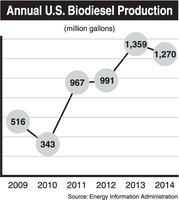Renewable Accounts: Big News for Biodiesel
(Click the image below to view a high-resolution image that can be downloaded)
By David Ripplinger, Bioproducts and Bioenergy Economist and Assistant Professor
NDSU Department of Agribusiness and Applied Economics
Christmas came early this year for the biodiesel industry with the Environmental Protection Agency’s announcement of final Renewable Fuel Standard volumes on Nov. 30. The domestic level of biodiesel use is mandated to increase to 2 billion gallons a year by 2017, double the minimum amount required by the original law.
How much biodiesel is that? Domestic biodiesel diesel production has averaged 1.3 billion gallons the last three years. The 2017 volumes are 50 percent higher. Two billion gallons is about 1.5 percent of annual domestic diesel use – both motor fuel and heating oil. It’s important to remember that there is no diesel blend wall, so this fuel is expected to be relatively easily absorbed by the market, with room for more.
What does this mean to the biodiesel industry? The current capacity of the domestic biofuel industry is 2.1 billion gallons. If the 2017 mandate is met, the biodiesel industry will be operating at near capacity, making the announcement very good news to those with mothballed biodiesel operations.
The 2.1 billion gallon capacity includes 85 million gallons at Archer Daniels Midland Co. in Velva. Will it commence full and regular biodiesel production? That will depend on the relative price of canola oil, which likely will result from abundant supplies and other biodiesel feedstocks.
Will oilseed crush plants add biodiesel capacity? Possibly. This will depend on the relative price of oils for food, feed, fuel and other uses. Fuel is at the base of the value-added pyramid. It can use a lot of material, but the margins are typically small.
What does this news mean to the oilseed industry? It takes a little more than 7.5 pounds of vegetable oil to produce a gallon of biodiesel. Increasing production by 700 million gallons means that there is a new home for 5.2 billion pounds of biodiesel feedstock. Sounds like it’s time to crush some oilseeds.
What does this news mean to soybean producers? Soybean oil is the primary biodiesel feedstock in the U.S. providing about half of the feedstock used annually. If soybean oil continues to provide 50 percent of the biodiesel feedstock, soybean oil use would increase by 50 percent, from 5 billion to 7.5 billion pounds. All the oil from 700 million bushels of soybeans, about the amount produced by the Dakotas and Minnesota in 2014, would be needed to meet the mandate. Obviously, this is bullish for soybeans.
NDSU Agriculture Communication - Dec. 7, 2015
| Source: | David Ripplinger, (701) 231-5265, david.ripplinger@ndsu.edu |
|---|---|
| Editor: | Kelli Armbruster, (701) 231-6136, kelli.armbruster@ndsu.edu |


